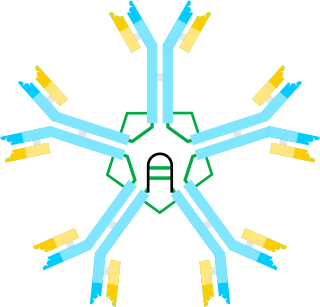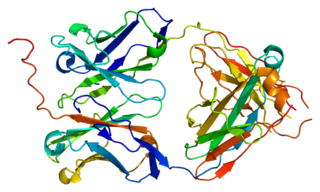Related Research Articles

Immunoglobulin M (IgM) is one of several isotypes of antibody that are produced by vertebrates. IgM is the largest antibody, and it is the first antibody to appear in the response to initial exposure to an antigen. In the case of humans and other mammals that have been studied, the spleen, where plasmablasts responsible for antibody production reside, is the major site of specific IgM production.

CD155 also known as the poliovirus receptor is a protein that in humans is encoded by the PVR gene.

Immunoglobulin class switching, also known as isotype switching, isotypic commutation or class-switch recombination (CSR), is a biological mechanism that changes a B cell's production of immunoglobulin from one type to another, such as from the isotype IgM to the isotype IgG. During this process, the constant-region portion of the antibody heavy chain is changed, but the variable region of the heavy chain stays the same. Since the variable region does not change, class switching does not affect antigen specificity. Instead, the antibody retains affinity for the same antigens, but can interact with different effector molecules.

A J chain is a protein component of the antibodies IgM and IgA. It is a 137 residue polypeptide, encoded by the IGJ gene.

Fc fragment of IgE, high affinity I, receptor for; alpha polypeptide, also known as FCER1A, is a protein which in humans is encoded by the FCER1A gene.

Immunoglobulin lambda-like polypeptide 1 is a protein that in humans is encoded by the IGLL1 gene. IGLL1 has also recently been designated CD179B.

Ig mu chain C region is a protein that in humans is encoded by the IGHM gene.

Leukocyte immunoglobulin-like receptor subfamily B member 2 is a protein that in humans is encoded by the LILRB2 gene.

Ig gamma-1 chain C region is a protein that in humans is encoded by the IGHG1 gene.
Immunoglobulin heavy constant alpha 1 is a immunoglobulin gene with symbol IGHA1. It encodes a constant (C) segment of Immunoglobulin A heavy chain. Immunoglobulin A is an antibody that plays a critical role in immune function in the mucous membranes. IgA shows the same typical structure of other antibody classes, with two heavy chains and two light chains, and four distinct domains: one variable region, and three variable regions. As a major class of immunoglobulin in body secretions, IgA plays a role in defending against infection, as well as preventing the access of foreign antigens to the immunologic system.
Immunoglobulin heavy locus, also known as IGH, is a region on human chromosome 14 that contains a gene for the heavy chains of human antibodies.
Ig delta chain C region is a protein that in humans is encoded by the IGHD gene.

Interleukin 21 receptor is a type I cytokine receptor. IL21R is its human gene.
Immunoglobulin lambda locus, also known as IGL@, is a region on human chromosome 22 that contains genes for the lambda light chains of antibodies.

Leukocyte immunoglobulin-like receptor subfamily B member 3 is a protein that in humans is encoded by the LILRB3 gene.

Leukocyte immunoglobulin-like receptor subfamily A member 2 is a protein that in humans is encoded by the LILRA2 gene.
Ig gamma-3 chain C region is a protein that in humans is encoded by the IGHG3 gene.

CD300A is a human gene.

Cationic amino acid transporter 4 is a protein that in humans is encoded by the SLC7A4 gene.
Antibody structure is made up of two heavy-chains and two light-chains. These chains are held together by disulfide bonds. The arrangement or processes that put together different parts of this antibody molecule play important role in antibody diversity and production of different subclasses or classes of antibodies. The organization and processes take place during the development and differentiation of B cells. That is, the controlled gene expression during transcription and translation coupled with the rearrangements of immunoglobulin gene segments result in the generation of antibody repertoire during development and maturation of B cells.
References
- ↑ Walter MA, Dosch HM, Cox DW (Aug 1991). "A deletion map of the human immunoglobulin heavy chain variable region". J Exp Med. 174 (2): 335–49. doi:10.1084/jem.174.2.335. PMC 2118905 . PMID 1649888.
- ↑ Schroeder HW Jr; Walter MA; Hofker MH; Ebens A; Willems van Dijk K; Liao LC; Cox DW; Milner EC; Perlmutter RM (Dec 1988). "Physical linkage of a human immunoglobulin heavy chain variable region gene segment to diversity and joining region elements". Proc Natl Acad Sci U S A. 85 (21): 8196–200. Bibcode:1988PNAS...85.8196S. doi: 10.1073/pnas.85.21.8196 . PMC 282394 . PMID 3141924.
- ↑ "Entrez Gene: IGHV@ immunoglobulin heavy variable group".
- ↑ Forconi F, Sozzi E, Cencini E, et al. (November 2009). "Hairy cell leukemias with unmutated IGHV genes define the minor subset refractory to single agent cladribine and with more aggressive behavior". Blood. 114 (21): 4696–4702. doi: 10.1182/blood-2009-03-212449 . PMID 19667403.